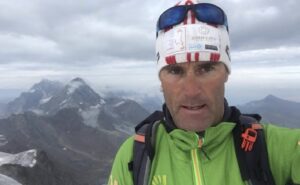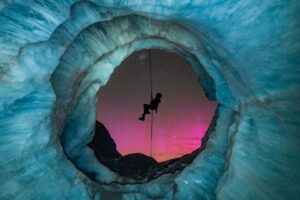Drones are becoming vital tools in high-altitude mountaineering for scouting routes, searching for missing climbers, even carrying vital supplies
In the last couple of years, drones have become as important a piece of climbing gear as crampons and down suits. The increasing need for professional and would-be professional mountaineers to document their ascents has made them a vital tool. Every mountain documentary now relies heavily on them: In The Ghosts Above, director Renan Ozturk used these UAVs, or unmanned aerial vehicles, at previously unthinkable altitudes to capture footage of climbers moving up Everest and of the north side’s upper sections.
But beyond their use for capturing landscape and action footage, drones explore route conditions ahead of the climbing teams and have already aided in several rescues.

Drone frame of climbers heading for Everest’s North Col. From The Ghosts Above, filmed by Renan Ozturk for National Geographic
Rescues on Broad Peak and Nanga Parbat
In summer 2018, drone pilot Bartek Bargiel came to the Karakorum to film his brother Andrzej’s ski descent of K2. But Bartek Bargiel’s piloting skills unexpectedly helped save the life of Rick Allen on neighboring Broad Peak. Allen was trying to open a new route when he suffered a fall while descending. Helicopters would not have reached him quickly, and a ground search would have forced rescuers to grope around in unknown, perilous terrain. Bartek’s drone soon located the stricken climber, below, and led searchers to him.

Andrzej Bargiel releases a drone on K2.
As for K2, the Bargiel brothers fulfilled their ambitions in one of the best expeditions that the Savage Mountain has ever seen. Bartek’s three drones filmed the entire climb and descent –- one of them flying to the very summit. Because it didn’t have the juice to get back down again, poor Andrzej had to shoulder it in his backpack during his historic ski descent. Bartek overrode the software on his drones to allow them to fly at 8,000m, which is considered jet airspace.
At one point, Bartek even adapted a drone to carry medicine higher up K2 to aid a stricken climber.

Andrzej Bargiel readies his drone to carry medicine up K2.
Months later, Alex Txikon and his team were airlifted from their own attempt on winter K2 to Nanga Parbat, where Daniele Nardi and Tom Ballard had recently gone missing on the Mummery Spur, a highly difficult route constantly swept by avalanches, as shown in the video. Txikon used drones to scout the Mummery Spur, in this case without success.
Txikon lost one of his drones when it ran out of power and landed somewhere off route, never to be seen again. It highlighted the main setback of drones in high mountain environments: their short flight times. Batteries drain fast at altitude and in the cold.
Why not on Winter K2?
That was the main reason why drones were not deployed during the search for Ali Sadpara, John Snorri, and Juan Pablo Mohr, who disappeared on K2 on February 5. Powerful drones and very skilled pilots would have been required, Moirah Ahmad (spokesperson for the Sadpara family) explained to ExplorersWeb. In any case, the winter conditions would not have allowed the drones to work properly. “It wasn’t just the cold,” explained Moirah Ahmad, “but also the strong wind, which nearly kept even the helicopters from flying.
Where and how are drones permitted?
Besides technological limitations, drones are subject to restrictions and regulations in several countries. The two searches mentioned above, in which drones played a major role, happened in Pakistan, and climbers had originally brought their UAVs for filming. In Pakistan, regulations on drones are relaxed, as long as the devices are used only for recreation in isolated mountain areas, and above all, far from military bases. The Pakistan Tourism Office has no statement about their use, although it would be wise to check in advance with tour operators or with Pakistan’s Civil Aviation Authority.

Flying a drone at Lungden (4,375m) on the Everest Trail. Video Frame: Aerial Projects
Nepal has many more rules. According to its Civil Aviation Authority, smaller drones (lighter than two kilos) are usually okay, as long as they don’t fly more than 120m above the ground and 500m from the pilot. They must also avoid large social gatherings, congested areas, and any vehicle or structure.
Those intending to use larger models and fly farther from the pilot — as on the big peaks — must obtain film permits from various government offices. Specialized websites such as UAV Coach point out that even smaller drones need a permit in certain areas, such as the Annapurna Conservation Area.
According to travelers’ forums, the permitting process takes at least three days and is best handled in advance through expedition agencies.
Everest: forbidden flying area?
Even these agencies are grappling with rapidly changing regulations, as drones’ popularity increases. Lukas Furtenbach has used drones on several expeditions, including on Everest over five years ago. “Nepal has changed the regulations since then,” Furtenbach told ExplorersWeb. “The permit currently costs about $5,000, and drones are not allowed close to the Chinese border anymore, including in the Everest area!”
This suggests why neither Alex Txikon’s team or Jost Kobusch’s photographer Daniel Hug used drones on their winter Everest expeditions in early 2020.
In general, though, Furtenbach is looking to expand his use of drones in the future. “We are currently working on a project to use heavy-payload drones to carry oxygen and other supplies to high camps,” he said. “The idea is not to replace Sherpas, but to make their work easier and safer.”
How About this year?
For those hoping to use drones on a post-COVID return to Nepal, Dawa Steven Sherpa of Asian Trekking offers updated information: “They are not forbidden at the moment,” he told ExplorersWeb. “They are restricted, but you can get a permit for them. The problem is, the permit application process can last 45 days and cost as much as $18,000, as nine different ministries and government departments are involved.” [The ministries are: Info and Comms, Civil Aviation, Forestry, Home and Defense, departments: Archaeology, national parks, Film Development Board and Civil Aviation Authority.]
“If you know how to navigate that, then you can get the permits,” Dawa Steven added. “It’s a regular part of my work, but it’s a major pain in the ass and basically takes up two to three hours per day for one full-time staff member for 45 days.”
As for trying to smuggle your drone hidden in your personal duffel, think twice. “The liaison officers on expeditions will check, as well as the SPCC [Sagarmatha Pollution Control Committee],” Dawa Steven said. “In the villages, the Nepal police will come and ask to see your drone and filming permits. So will the forest rangers, game scouts, and even the army. There’s little chance of getting away with [smuggling in a drone] on Everest.”
Drone footage in Nepal’s Himalaya, including Everest BC and the Khumbu Icefall, Gokyo Lakes, Cho La Pass, and Renjo La Pass, shared by DroneOut.






